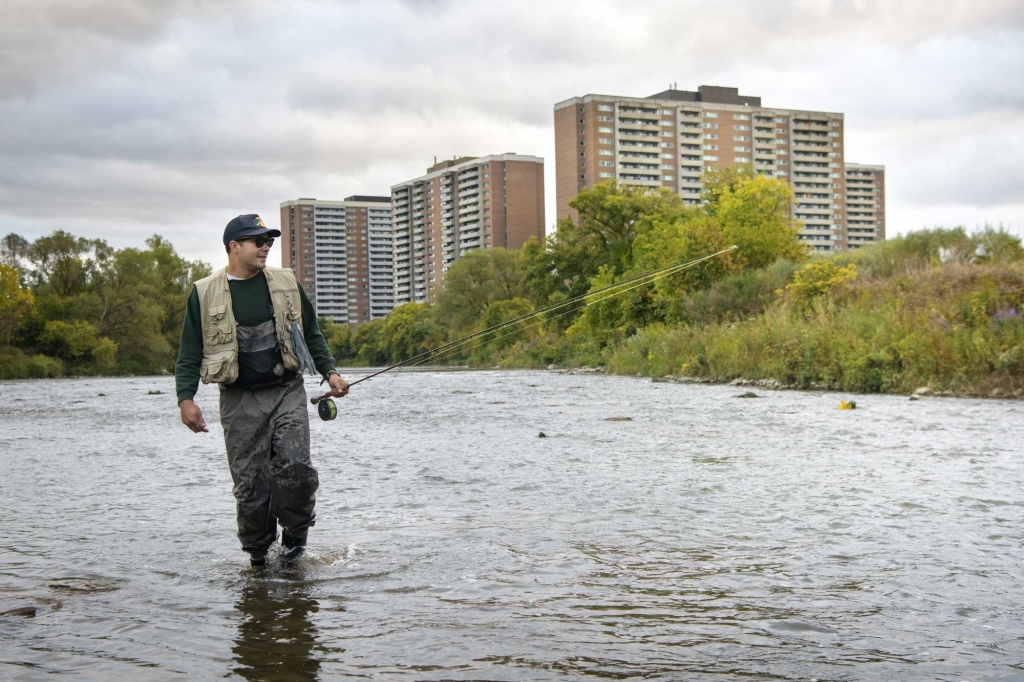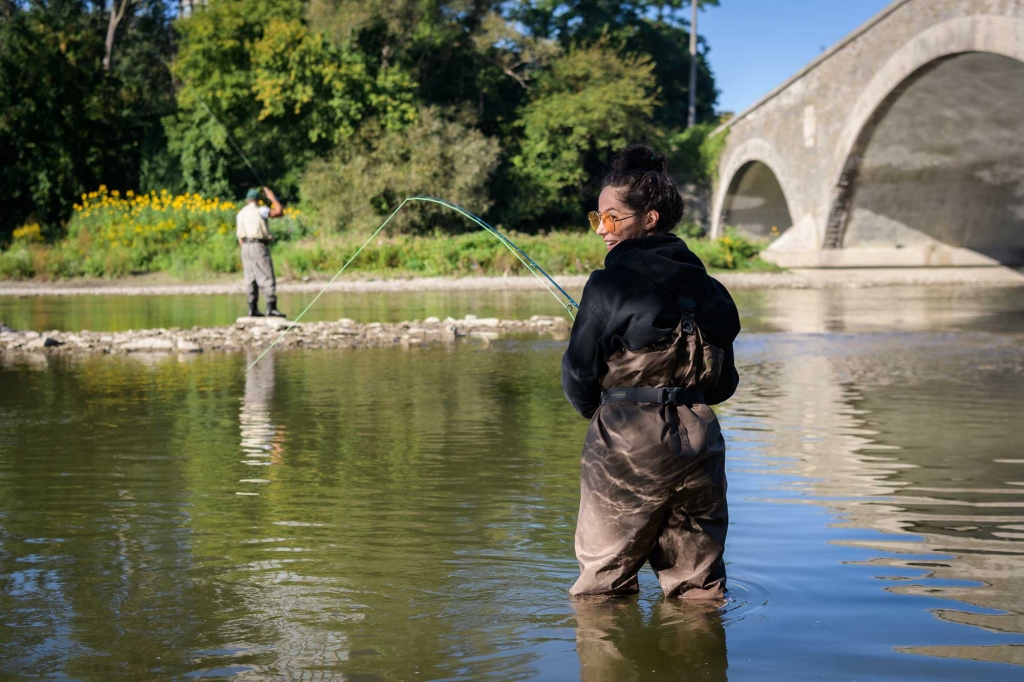Besiders
City Fisher
Most people associate salmon fishing with expensive trips to remote rivers. But in Toronto, the salmon are just a subway ride away.
TEXT Mark Mann
PHOTOS David Coulson
Come out the door of the Old Mill subway station in Toronto on any cool day in late September or early October, turn right, and within 1,000 feet you’ll walk straight into one of the most unique and bustling salmon fisheries in the world, and one of the city’s best-kept secrets.
After a heavy rain, when the temperature dips below 10 °C, dozens of urban fishers converge near the overpass that crosses the Humber River to catch the passing chinook, coho, and Atlantic salmon that race up the river to spawn.
If you go early enough, you might find Gavin Odho wading out in the water before work, with his trusty rod and a fuzzy white hand-tied fly that he made at his kitchen table. He calls it “White Death,” and he swears by it. “You gotta name them,” he says.
Odho, a home renovator, grew up in the city and never learned to fish when he was a kid. “But I always liked the idea of it, even as a young teenager in Toronto,” he tells me. As an adolescent, Odho started taking a rod down to a large pond in one of the city parks, without much success. Luckily, he began spending summers on his step-granddad’s farm outside the city, where he picked up some of the fishing basics.
After graduating from high school, Odho’s shop teacher started taking him out and showing him the finer points of fly-fishing. “He’s one of these beautiful outdoorsman guys who respects nature and gets out as often as he can—a warm, kind person who brings all the sandwiches and makes sure you’re taken care of,” Odho says.
Toronto and its surrounding metropolitan areas are home to more than a dozen urban river valleys. Once a natural network of trade and travel routes for the Iroquois and Mississauga people, long before the European settlers arrived in the 18th century, these waterways now run beneath the shadows of tall buildings and overhanging bridges that rumble with traffic and streetcars.

For millennia, these rivers served as spawning grounds for a native subspecies of Atlantic salmon that used Lake Ontario as if it were their ocean. Then, beginning in the 1800s, city planners started installing dams throughout Toronto’s urban rivers. Atlantic salmon can jump as high as 10 feet, but that still wasn’t high enough to overcome the obstacles that kept them from returning home to lay their eggs. Along with overfishing, this led to the original Atlantic salmon in Lake Ontario’s complete extinction by the end of the 1880s.
The disappearance of this top predator created a massive gap in the food chain, allowing smaller fish to spawn out of control. Seeking to redress the problem, the province of Ontario began stocking the lake with both Atlantic and Pacific salmon in the 1960s, and modifying the dams to help fish return to the spawning grounds. Slowly, the salmon are reclaiming their wild habitat, but it’s a delicate balance, and the province still has to stock hundreds of thousands every year.

The revived presence of salmon in Lake Ontario has made the sport accessible for downtowners like Odho and his girlfriend Manuela, an arborist. In fact, their first date was fly-fishing the Humber; she’d never done it before, but they now share a passion for catching salmon.
“Manu kicks ass at fishing,” Odho says proudly. She smiles modestly: “It’s hard to land them, that’s for sure.”

But the accessibility of this urban fishery also draws crowds of inexperienced or irresponsible locals who engage in less-than-sportsmanlike behaviour, says Rob Cesta, owner of Drift Outfitters & Fly Shop in Toronto. It’s not out of the ordinary to see people going after salmon with nets and machetes, or dragging large hooks across the water to snag them, rather than properly enticing the fish to take a lure.
And since Atlantic salmon are a protected species, not throwing them back is considered poaching, a criminal offence with some hefty penalties. Many fishers don’t know how to distinguish Atlantic from Pacific salmon, or even rainbow trout. Some unscrupulous fishers will cut them open and take their eggs as bait to catch other fish. It is okay to take home a limited amount of Pacific salmon, however.


There’s a lot of education that needs to be done, says Cesta, but there’s no doubt that catching salmon in Toronto’s downtown rivers is a rare joy. Adult salmon are more than two feet long and can weigh 30 pounds or more. Most, like Odho, are in it for the thrill of the catch. They snap a photo and quickly release their prize so it can continue its journey upriver. Then they pack up their gear and walk up the hill to catch the subway home.
______________________
Mark Mann is an independent journalist and writer based in Montreal, specializing in narrative longform essays and reported features, as well as cultural criticism. He is a senior editor at BESIDE magazine, a contributing editor at the art publication Momus, and he produces a newsletter about the innovation economy called Research Money.
Never Miss Another Issue
Two issues per year
25% OFF previous issues
Free Shipping in Canada





